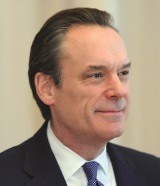 |
| Power Africa officials talk with locals inside the Corbetti Caldera, Ethiopia, where villagers collect water from steam emanating from the rocks. Photo credit: Nena Terrell, USAID Ethiopia |
US president Barack Obama’s Power Africa initiative received new financial commitments worth $6 billion following the high profile US-Africa Leaders Summit in Washington in August, bringing the total amount committed to the project to more than $20 billion.
Banks have been at the forefront of the scheme, with Citi, Barclays, Standard Chartered and Standard Bank among those pledging vast amounts to it.
Standard Chartered, which had initially pledged $2 billion, more than doubled its commitment to $5 billion a few days before the summit kicked off, while Barclays Africa and Standard Bank have committed $500 million and $350 million respectively to the pipeline of proposed power projects.
 |
| There was a sense at the summit of America catching up in terms of investment and trade in to Africa George Kotsovos |
“As part of our pledge, we have signed a memorandum of understanding with General Electric (GE) to boost the African energy sector,” says George Kotsovos, director of mining, energy and infrastructure finance at Standard Bank.
“This is one of the projects we are working on in support of the Power Africa initiative, but outside this, we have invested billions of dollars to the energy sector in Africa over the years. The good thing about Power Africa, however, is that it is a high-profile and focussed initiative, which has really highlighted the importance of Africa as a destination for investment – it’s about capacity building mobilizing funds into partner countries and it is important for us to get involved.”
During the summit, Citi also vowed to source $2.5 billion in incremental capital. “We plan to leverage our financing expertise in renewable energy to encourage the adoption and implementation of the appropriate technologies for specific markets,” says Jim Cowles, CEO for EMEA at Citi. “The bank will work with key stakeholders in local capital markets to introduce innovative debt securities and to enhance financial infrastructure.”
Power Africa, established in June 2013 during a visit by Obama to Cape Town, aims to provide electricity for the 600 million people in sub-Saharan Africa – around 70% of the population – that live without it. The initiative plans to tap into opportunities in natural gas, wind, solar and hydropower in the region to encourage economic development and increase energy security throughout the region.
In 2013, 10,000 megawatts of generation capacity were planned for. Following August’s Washington summit, the goal was raised to 30,000 megawatts, which could potentially provide 60 million people in the region.
Focus will initially be in six countries: Ethiopia, Ghana, Kenya, Liberia, Nigeria and Tanzania.
“One of the issues that came up during the summit was how we will eventually move to include other countries that are equally affected by the power deficit in Africa,” says Kotsovos. “The aim is to encompass more African countries into the initiative, and we hope to hear an announcement on this soon.”
As Ravi Suri, regional head of corporate finance, Middle East, Africa and Pakistan at Standard Chartered says: “Power Africa will also seek to improve natural resource management in other Sub-Saharan African countries such as Democratic Republic of Congo, Uganda, South Sudan, and Mozambique, in an effort to facilitate broader economic development for the benefit of regional trade and investment.”
Playing catch-up
A number of other agreements were promised during the high-profile meeting, with a total of $33 billion pledged in private and public assistance from the US to the continent, highlighting the US drive to strengthen the bilateral relationship between the two continents. This will inevitably be a boon to US-Africa relations, which have traditionally relied on a unilateral relationship of aid and preferential trade agreements.
 |
| [Citi] will work with key stakeholders in local capital markets to introduce innovative debt securities and to enhance financial infrastructure Jim Cowles |
The summit also aimed to encourage US-Africa trade, which is currently limited, with only 1% of US exports going to the continent. According to US government data, US trade with Africa has been decreasing since 2011: between 2011 and 2012, US-Africa trade dropped from $125 billion to $99 billion and in 2013, trade between the two regions fell to a disappointing $85 billion. The onset of the global financial crisis has been cited as a cause of the dwindling numbers.
However, at the same time, trade between Africa and China has gone from strength to strength. Official Chinese statistics show that trade between the two surged to $210 billion at the end of 2013, 21 times more than in 2000.
“There was a sense at the summit of America catching up in terms of investment and trade in to Africa, but I was actually surprised, firstly by the commitments by American companies that are already there and secondly by how much interest there actually was,” says Kotsovos.
“There are a number of America companies including GE, Google, Blackstone, Solar Reserve, Endeavour Energy and Tetra Tech already active on the ground in Africa. The summit has ensured that there will be more,” he says.